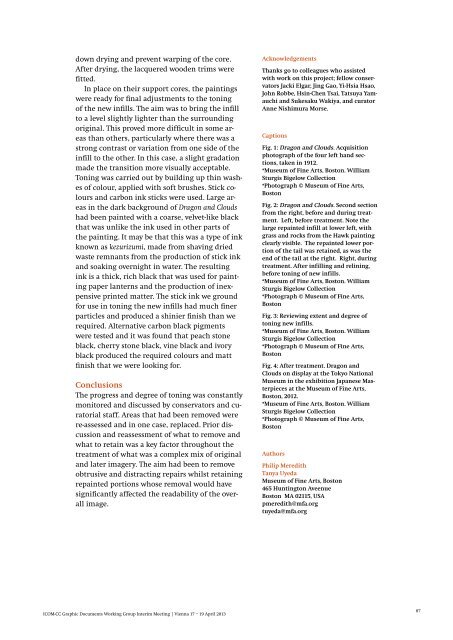Paper Conservation: Decisions & Compromises
Paper Conservation: Decisions & Compromises
Paper Conservation: Decisions & Compromises
You also want an ePaper? Increase the reach of your titles
YUMPU automatically turns print PDFs into web optimized ePapers that Google loves.
down drying and prevent warping of the core.<br />
After drying, the lacquered wooden trims were<br />
fitted.<br />
In place on their support cores, the paintings<br />
were ready for final adjustments to the toning<br />
of the new infills. The aim was to bring the infill<br />
to a level slightly lighter than the surrounding<br />
original. This proved more difficult in some areas<br />
than others, particularly where there was a<br />
strong contrast or variation from one side of the<br />
infill to the other. In this case, a slight gradation<br />
made the transition more visually acceptable.<br />
Toning was carried out by building up thin washes<br />
of colour, applied with soft brushes. Stick colours<br />
and carbon ink sticks were used. Large areas<br />
in the dark background of Dragon and Clouds<br />
had been painted with a coarse, velvet-like black<br />
that was unlike the ink used in other parts of<br />
the painting. It may be that this was a type of ink<br />
known as kezurizumi, made from shaving dried<br />
waste remnants from the production of stick ink<br />
and soaking overnight in water. The resulting<br />
ink is a thick, rich black that was used for painting<br />
paper lanterns and the production of inexpensive<br />
printed matter. The stick ink we ground<br />
for use in toning the new infills had much finer<br />
particles and produced a shinier finish than we<br />
required. Alternative carbon black pigments<br />
were tested and it was found that peach stone<br />
black, cherry stone black, vine black and ivory<br />
black produced the required colours and matt<br />
finish that we were looking for.<br />
Conclusions<br />
The progress and degree of toning was constantly<br />
monitored and discussed by conservators and curatorial<br />
staff. Areas that had been removed were<br />
re-assessed and in one case, replaced. Prior discussion<br />
and reassessment of what to remove and<br />
what to retain was a key factor throughout the<br />
treatment of what was a complex mix of original<br />
and later imagery. The aim had been to remove<br />
obtrusive and distracting repairs whilst retaining<br />
repainted portions whose removal would have<br />
significantly affected the readability of the overall<br />
image.<br />
Acknowledgements<br />
Thanks go to colleagues who assisted<br />
with work on this project; fellow conservators<br />
Jacki Elgar, Jing Gao, Yi-Hsia Hsao,<br />
John Robbe, Hsin-Chen Tsai, Tatsuya Yamauchi<br />
and Sukesaku Wakiya, and curator<br />
Anne Nishimura Morse.<br />
Captions<br />
Fig. 1: Dragon and Clouds. Acquisition<br />
photograph of the four left hand sections,<br />
taken in 1912.<br />
*Museum of Fine Arts, Boston. William<br />
Sturgis Bigelow Collection<br />
*Photograph © Museum of Fine Arts,<br />
Boston<br />
Fig. 2: Dragon and Clouds. Second section<br />
from the right, before and during treatment.<br />
Left, before treatment. Note the<br />
large repainted infill at lower left, with<br />
grass and rocks from the Hawk painting<br />
clearly visible. The repainted lower portion<br />
of the tail was retained, as was the<br />
end of the tail at the right. Right, during<br />
treatment. After infilling and relining,<br />
before toning of new infills.<br />
*Museum of Fine Arts, Boston. William<br />
Sturgis Bigelow Collection<br />
*Photograph © Museum of Fine Arts,<br />
Boston<br />
Fig. 3: Reviewing extent and degree of<br />
toning new infills.<br />
*Museum of Fine Arts, Boston. William<br />
Sturgis Bigelow Collection<br />
*Photograph © Museum of Fine Arts,<br />
Boston<br />
Fig. 4: After treatment. Dragon and<br />
Clouds on display at the Tokyo National<br />
Museum in the exhibition Japanese Masterpieces<br />
at the Museum of Fine Arts,<br />
Boston, 2012.<br />
*Museum of Fine Arts, Boston. William<br />
Sturgis Bigelow Collection<br />
*Photograph © Museum of Fine Arts,<br />
Boston<br />
Authors<br />
Philip Meredith<br />
Tanya Uyeda<br />
Museum of Fine Arts, Boston<br />
465 Huntington Aveenue<br />
Boston MA 02115, USA<br />
pmeredith@mfa.org<br />
tuyeda@mfa.org<br />
ICOM-CC Graphic Documents Working Group Interim Meeting | Vienna 17 – 19 April 2013<br />
87
















